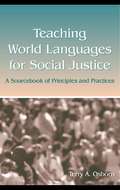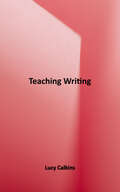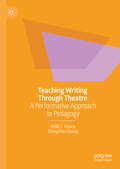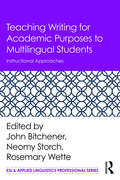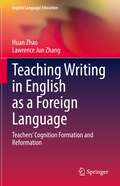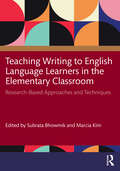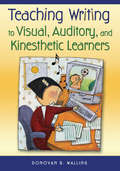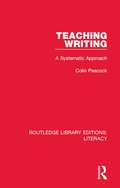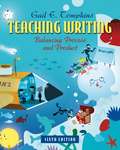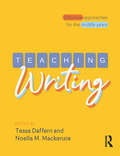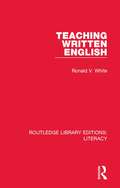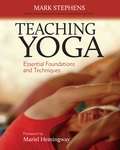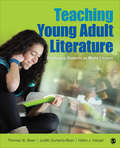- Table View
- List View
Teaching World Languages for Social Justice: A Sourcebook of Principles and Practices
by Terry A. OsbornTeaching World Languages for Social Justice: A Sourcebook of Principles and Practices offers principles based on theory, and innovative concepts, approaches, and practices illustrated through concrete examples, for promoting social justice and developing a critical praxis in foreign language classrooms in the U.S. and in wider world language communities. For educators seeking to translate these ideals into classroom practice in an environment dominated by the current standards movement and accountability measures, the critical insights on language education offered in this text will be widely welcomed.The text is designed as a sourcebook for translating theory into practice. Each chapter includes the theoretical base, guidelines for practice, discussion of the relationship to existing practices in the world language classroom, suggestions for activity development (which can be integrated into a professional portfolio), illustrative examples, questions for reflection, and additional suggested readings.Teaching World Languages for Social Justice is a primary or supplementary text for second and foreign language teaching methods courses and is equally appropriate for graduate courses in language education or educational studies.
Teaching World Languages with the Five Senses: Practical Strategies and Ideas for Hands-On Learning
by Elizabeth PorterWith this fun, practical guide, you will have everything you need to re-envision and reinvigorate your world language classroom. Author Elizabeth Porter draws on a brain-based approach to show how language learning is a sensory experience. Students can effectively learn languages and improve retention through activities and lessons that incorporate the five senses – sight, hearing, taste, touch, and smell. Chapters include real-world, research-backed examples and classroom strategies and activities ready for use. An essential resource for world language teachers, this book introduces language learning philosophy and an out-of-the-box, effective approach that uses neuroscience combined with best practices to promote a highly engaging language learning environment.
Teaching World Languages with the Five Senses: Practical Strategies and Ideas for Hands-On Learning
by Elizabeth PorterWith this fun, practical guide, you will have everything you need to re-envision and reinvigorate your world language classroom. Author Elizabeth Porter draws on a brain-based approach to show how language learning is a sensory experience. Students can effectively learn languages and improve retention through activities and lessons that incorporate the five senses – sight, hearing, taste, touch, and smell. Chapters include real-world, research-backed examples and classroom strategies and activities ready for use. An essential resource for world language teachers, this book introduces language learning philosophy and an out-of-the-box, effective approach that uses neuroscience combined with best practices to promote a highly engaging language learning environment.
Teaching Writing
by Lucy CalkinsWriting allows each of us to live with that special wide-awakeness that comes from knowing that our lives and our ideas are worth writing about. -Lucy Calkins Teaching Writing is Lucy Calkins at her best-a distillation of the work that's placed Lucy and her colleagues at the forefront of the teaching of writing for over thirty years. This book promises to inspire teachers to teach with renewed passion and power and to invigorate the entire school day. This is a book for readers who want an introduction to the writing workshop, and for those who've lived and breathed this work for decades. Although Lucy addresses the familiar topics writing process, conferring, kinds of writing, and writing assessment- she helps us see those topics with new eyes. She clears away the debris to show us the teeny details, and she shows us the majesty and meaning, too, in these simple yet powerful teaching acts.
Teaching Writing Through Theatre: A Performative Approach to Pedagogy
by Dongshin Chang Kelly I. AlianoThis volume presents an introspective study of writing pedagogy, explored through the lens of theatre and performance. The chapters explore assessment and issues related to student engagement, in both in-person and online learning spaces, and consider aspects such as class design, environment, activities, and curriculum. The authors draw on educational theory and inquiry-based pedagogy as well as their own experiences to lay out a comprehensive blueprint for teaching in a student centered classroom.
Teaching Writing for Academic Purposes to Multilingual Students: Instructional Approaches (ESL & Applied Linguistics Professional Series)
by Neomy Storch John Bitchener Rosemary WetteExamining what is involved in learning to write for academic purposes from a variety of perspectives, this book focuses in particular on issues related to academic writing instruction in diverse contexts, both geographical and disciplinary. Informed by current theory and research, leading experts in the field explain and illustrate instructional programs, tasks, and activities that help L2/multilingual writers develop knowledge of different genres, disciplinary expectations, and expertise in applying what they have learned in both educational and professional contexts.
Teaching Writing in English as a Foreign Language: Teachers’ Cognition Formation and Reformation (English Language Education #28)
by Lawrence Jun Zhang Huan ZhaoThis book explores teachers’ cognitions about the teaching of writing in English as a foreign language (EFL) and their teaching practice, as well as factors influencing the formation and reformation process of their cognition. Taking stock of Bakhtin’s dialogism as the theoretical framework, the authors argue that the formation and reformation of teacher cognition is a dialogic process. A systematic analysis of participating teachers’ cognition formation and re-formation process suggests the highly individual nature of teachers’ cognitions. EFL researchers and teachers, teacher educators, teacher education policymakers, university administrators and EFL textbook writers could draw on the findings of the study to provide better resources to implement the teaching of EFL writing more effectively. The study has adopted a mixed-methods approach, whose quantitative results show the patterns and differences of teacher cognition among teachers of different backgrounds and with different schooling, education and working experiences. The qualitative findings show in detail teachers' cognition formation and reformation processes and the factors contributing to such processes, revealing convergence and divergence of teachers’ stated cognitions, with a focus on the discrepancy between teacher cognition and teaching practice. These are useful lenses through which researchers and teachers will find significant implications for offering EFL writing instruction more effectively.
Teaching Writing in the Health Professions: Perspectives, Problems, and Practices
by Michael J. MadsonThis collection provides a research-based guide to instructional practices for writing in the health professions, promoting faculty development and bringing together perspectives from writing studies, technical communication, and health humanities. With employment in health-care sectors booming, writing instruction tailored for the health professions is in high demand. Writing instruction is critical in the health professions because health professionals, current and aspiring, need to communicate persuasively with patients, peers, mentors, and others. Writing instruction can also help cultivate professional identity, reflective practice, empathy, critical thinking, confidence, and organization, as well as research skills. This collection prepares faculty and administrators to meet this demand. It combines conceptual development of writing for the health professions as an emergent interdiscipline with evidence-based practices for instructors in academic, clinical, and community settings. Teaching Writing in the Health Professions is an essential resource for instructors, scholars, and program administrators in health disciplines, professional and technical communication, health humanities, and interdisciplinary writing studies. It informs the teaching of writing in programs in medicine, nursing, pharmacy and allied health, public health, and other related professions.
Teaching Writing in the Twenty-First Century
by Beth L. Hewett Tiffany Bourelle Scott WarnockTeaching Writing in the Twenty-First Century is a comprehensive introduction to writing instruction in an increasingly digital world. It provides both a theoretical background and detailed practical guidance to writing instructors faced with novel and ever-changing digital learning technologies, new approaches to access needs and usability design, increasing student diversity, and the multiliteracies of reading, alphabetic writing, and multimodal composition. A companion volume, Administering Writing Programs in the Twenty-First Century, considers the role of administrators in addressing these issues.Covering all aspects of teaching online, various composition genres, and the technologies available to teachers, Teaching Writing in the Twenty-First Century addresses composing processes and approaches; designing and scaffolding assignments; providing response, feedback, and evaluation; communicating effectively; and supporting students. These strategic and practical ideas are prefaced by a history of the relation between composition and rhetoric and a guide to diversity, inclusion, and access. The volume ends with a chapter on envisioning the future of composition.
Teaching Writing to Children in Indigenous Languages: Instructional Practices from Global Contexts (Routledge Research in Education #37)
by Ari Sherris Joy Kreeft PeytonThis volume brings together studies of instructional writing practices and the products of those practices from diverse Indigenous languages and cultures. By analyzing a rich diversity of contexts—Finland, Ghana, Hawaii, Mexico, Papua New Guinea, and more—through biliteracy, complexity, and genre theories, this book explores and demonstrates critical components of writing pedagogy and development. Because the volume focuses on Indigenous languages, it questions center-margin perspectives on schooling and national language ideologies, which often limit the number of Indigenous languages taught, the domains of study, and the age groups included.
Teaching Writing to English Language Learners in the Elementary Classroom: Research-Based Approaches and Techniques
by Subrata BhowmikThis book focuses on research-informed approaches and techniques for teaching writing to elementary English Language Learners (ELLs). The book highlights strategies for enriching writing literacy education for elementary ELLs. With contributions from prominent scholars in the field of elementary ELL writing from around the world, the chapters in this book focus on a wide range of topics, including curriculum design, metalanguage and translanguaging, integrating playfulness into a genre-based approach to writing instruction, metacognitive instruction, teaching the genre of school, identity texts, multimodal writing, using mentor texts, teaching science writing, and interrogating raciolinguistic ideologies in assessment practices. Together they highlight both the challenges and possibilities of writing instruction for elementary ELLs in diverse educational contexts.This is a foundational text for students in TESOL programs focusing on writing instruction for ELLs, as well as for pre- and in-service teachers who want to upgrade their teaching abilities and knowledge bases.
Teaching Writing to Visual, Auditory, and Kinesthetic Learners
by Donovan R. WallingThis resource offers differentiated teaching techniques and sample lessons for writing and thinking skills that emphasize fluency, artistry, walkabout strategies, pattern and rhythm, and more!
Teaching Writing, Rhetoric, and Reason at the Globalizing University (Routledge Research in Writing Studies)
by Robert SamuelsThis timely intervention into composition studies presents a case for the need to teach all students a shared system of communication and logic based on the modern globalizing ideals of universality, neutrality, and empiricism. Based on a series of close readings of contemporary writing by Stanley Fish, Asao Inoue, Doug Downs and Elizabeth Wardle, Richard Rorty, Slavoj Zizek, and Steven Pinker, this book critiques recent arguments that traditional approaches to teaching writing, grammar, and argumentation foster marginalization, oppression, and the restriction of student agency. Instead, it argues that the best way to educate and empower a diverse global student body is to promote a mode of academic discourse dedicated to the impartial judgment of empirical facts communicated in an open and clear manner. It provides a critical analysis of core topics in composition studies, including the teaching of grammar; notions of objectivity and neutrality; empiricism and pragmatism; identity politics; and postmodernism. Aimed at graduate students and junior instructors in rhetoric and composition, as well as more seasoned scholars and program administrators, this polemical book provides an accessible staging of key debates that all writing instructors must grapple with.
Teaching Writing: A Systematic Approach (Routledge Library Editions: Literacy #18)
by Colin PeacockOriginally published in 1986. The traditional approach to teaching writing concentrates on mastering the different aspects of writing in the hope that these will eventually unite as a set of integrated skills. More 'progressive' teachers emphasise that writing is a total process which is 'caught' intuitively rather than explicitly taught. Both models are partially unsatisfactory, and consequently a third approach has evolved which seeks to combine the best of both. This book considers this 'systematic' approach, which seeks to retain the emphasis on writing as a total process but identifies within each communicative context the set of sub-skills involved. The author discusses and illustrates the strengths and weaknesses of this approach and the changes in professional thinking and practice that are essential to its successful adoption. He presents an overview of the nature of the writing process, to enable teachers to make clearer and more explicit statements about their objectives in setting classroom writing tasks.
Teaching Writing: Balancing Process and Product (Sixth Edition)
by Gail E. TompkinsThis best selling text by Gail Tompkins thoroughly examines genres and instructional procedures with a strong new focus on differentiating instruction to ensure success for all writing students. New chapters on the writer's craft and on writing across the curriculum offer detailed information on the six traits of good writing as well as writing in content areas, and new features provide insight into teaching English learners and using technology meaningfully in the writing classroom.
Teaching Writing: Effective approaches for the middle years
by Tessa DaffernIn the 21st century, writing is more important than at any other time in human history. Yet much of the emphasis in schooling has been on reading, and after the early years, writing skills have been given less attention. Internationally, too many children are leaving school without the writing skills they need to succeed in life. The evidence indicates that students rarely develop proficiency as writers without effective teacher instruction. Teaching Writing offers a comprehensive approach for the middle years of schooling, when the groundwork should be laid for the demanding writing tasks of senior school and the workplace. Teaching Writing outlines evidence-based principles of writing instruction for upper primary students and young adolescents. It presents strategies that are ready for adoption or adaptation, and exemplars to assist with designing and implementing writing lessons across the middle years of school. It addresses writing from a multimodal perspective while also highlighting the importance of teaching linguistic aspects of text design such as sentence structure, vocabulary and spelling as foundations for meaning-making. Contributors argue that students need to continue to develop their skills in both handwriting and keyboarding. Examples of the teaching of writing across disciplines are presented through a range of vignettes. Strategies for assessing student writing and for supporting students with diverse needs are also explored. With contributions from leading literacy educators, Teaching Writing is an invaluable resource for primary, secondary and pre-service teachers.
Teaching Written English (Routledge Library Editions: Literacy #25)
by Ronald V. WhiteOriginally published in 1980. This practical guide to the teaching of writing is set in the context of the functional use of language for communication. It examines what communicating in writing involves and gives detailed procedures for teaching different types of writing from beginner to advanced level, together with illustrated suggestions for visual aids. This provides up-to-date ideas and advice for teachers and trainee teachers of English as a Foreign Language.
Teaching Yoga, Second Edition: A Comprehensive Guide for Yoga Teachers and Trainers: A Yoga Alliance-Aligned Manual of Asanas, Breathing Techniques, Yogic Foundations, and More
by Mark StephensThe bestselling guide for yoga teachers and trainers, revised and updated—a comprehensive Yoga Alliance-aligned manual of asanas, breathing techniques, yogic foundations, and more.Revised and updated, Teaching Yoga by yoga expert Mark Stephens is one of the most popular resources for new and experienced teachers, and has been a trusted guide since its publication in 2010.This classic resource covers fundamental topics of yoga history and philosophy, as well as each of the 11 major styles of contemporary yoga. There is also practical advice for every stage of the teaching process, including tools for teaching 108 yoga poses (asanas), breathing techniques (pranayama), and meditation.The 2nd edition—adapted to meet the needs of the modern yoga teacher—features:Updated sections on yoga history and philosophyDiscussions of trauma-sensitive yogaCoverage of cultural appropriation, racism, and sexism in yoga An inclusive approach that expands beyond the traditional vinyasa flow styleNew photos and illustrations1-page summaries after each chapterAn extended list of references for further learningDeveloped to meet 100% of the teacher training curriculum standards set by Yoga Alliance, the world&’s leading registry and accreditation source for yoga teachers and schools, Teaching Yoga is ideal for use as a core textbook in yoga teacher training programs.
Teaching Yoga: Essential Foundations and Techniques
by Mariel Hemingway Mark StephensTeaching Yoga is an essential resource for new and experienced teachers as well as a guide for all yoga students interested in refining their skills and knowledge. Addressing 100% of the teacher training curriculum standards set by Yoga Alliance, the world's leading registry and accreditation source for yoga teachers and schools, Teaching Yoga is also ideal for use as a core textbook in yoga teacher training programs. Drawing on a wide spectrum of perspectives, and featuring more than 150 photographs and illustrations, the book covers fundamental topics of yoga philosophy and history, including a historical presentation of classical yoga literature: the Vedas, Upanishads, Bhagavad Gita, Yoga Sutras of Pataljali, and the main historical sources on tantra and early hatha yoga. Each of the eleven major styles of contemporary yoga is described, with a brief history of its development and the distinguishing elements of its teachings. Exploring traditional and modern aspects of anatomy and physiology, the book provides extensive support and tools for teaching 108 yoga poses (asanas), breathing techniques (pranayama), and meditation. Teaching Yoga offers practical advice for classroom setup, planning and sequencing classes, as well as the process involved in becoming a teacher and sustaining oneself in the profession. The book has over 200 bibliographic sources, a comprehensive index, and a useful appendix that lists associations, institutes, organizations, and professional resources for yoga teachers.From the Trade Paperback edition.
Teaching Young Adult Literature (Options for Teaching #50)
by Mike Cadden, Karen Coats, and Roberta Seelinger TritesThanks to the success of franchises such as The Hunger Games and Twilight, young adult literature has reached a new level of prominence and popularity. Teens and adults alike are drawn to the genre's coming-of-age themes, fast pacing, and vivid emotional portrayals. The essays in this volume suggest ways high school and college instructors can incorporate YA texts into courses in literature, education, library science, and general education.The first group of essays explores key issues in YA literature, situates works in cultural contexts, and addresses questions of text selection and censorship. The second section discusses a range of genres within YA literature, including both realistic and speculative fiction as well as verse narratives, comics, and film. The final section offers ideas for assignments, including interdisciplinary and digital projects, in a variety of courses.
Teaching Young Adult Literature: Developing Students as World Citizens
by Thomas W. Bean Judithann Dunkerly-Bean Helen J. HarperTeaching Young Adult Literature: Developing Students As World Citizens (by Thomas W. Bean, Judith Dunkerly-Bean, and Helen Harper) is a middle and secondary school methods text that introduces pre-service teachers in teacher credential programs and in-service teachers pursuing a Masters degree in Education to the field of young adult literature for use in contemporary contexts. The text introduces teachers to current research on adolescent life and literacy; the new and expanding genres of young adult literature; teaching approaches and practical strategies for using young adult literature in English and Language Arts secondary classrooms and in Content Area Subjects (e.g. History); and ongoing social, political and pedagogical issues of English and Language Arts classrooms in relation to contemporary young adult literature.
Teaching Young Adults: A Handbook for Teachers in Post-Compulsory Education
by Trevor Dawn Joe Harkin Gill TurnerFurther and Higher Education in the UK has expanded greatly in recent years, bringing into education large numbers of young people who present teachers with new challenges. At the same time, there is an immense pressure to improve the quality of learning and teaching, and to encourage students to be active participants in the process. This book is aimed at teachers, aspiring teachers and other professionals in upper secondary schools, further education colleges and universities who wish to increase learner motivation and to create opportunities for greater learner autonomy. It will:* relate learning theory to practice* provide practical help for teachers to understand how they tend to interact with students* suggest how they may build a repertoire of teaching styles that foster sharing of responsibility with learners for more effective learning.
Teaching Young Children Mathematics
by Janice Minetola Robert G. Ziegenfuss J. Kent ChrismanTeaching Young Children Mathematics provides a comprehensive overview of mathematics instruction in the early childhood classroom. Taking into account family differences, language barriers, and the presence of special needs students in many classrooms throughout the U.S., this textbook situates best practices for mathematics instruction within the larger frameworks of federal and state standards as well as contemporary understandings of child development. Key topics covered include: developmental information of conceptual understanding in mathematics from birth through 3rd grade, use of national and state standards in math, including the new Common Core State Standards, information for adapting ideas to meet special needs and English Language Learners, literacy connections in each chapter, ‘real-world’ connections to the content, and information for family connections to the content.
Teaching Young Children With ADHD: Successful Strategies and Practical Interventions for PreK-3
by David Rosenthal Silvia L. Deruvo Richard A. LougyProvides teachers with an understanding of ADHD and how it manifests in young children, clarifying the what, why, and how of inclusive strategies that work.
Teaching Young Children in Violent Times: Building a Peaceable Classroom (Second Edition)
by Diane E. LevinA required book for early childhood educators, parents, and policy makers as it helps teachers create a Peaceable Classroom, where children learn peaceful alternatives to the violent behaviors modeled for them in society. <P><P>This extensively revised and updated edition features new material for a post-September 11th world including a new chapter on helping children deal with violence in the news.
